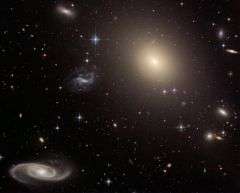The Oddball Hosts of Gamma-ray Bursts

There's a universal tendency to heed Dylan Thomas's exhortation and go out with a bang instead of a whimper. Nowhere is this more evident than deep in the cosmos.
When their time is up, stars make their exits in a number of flamboyant ways. The most massive stars leave with the greatest fanfare of all – blasting out gamma-ray bursts (GRBs), tremendous explosions that rock the Universe like nothing else. These spectacular blasts, second in power only to the Big Bang, occur when stars 50 to 100 times more massive than our sun use up all their fuel and collapse. Most astrophysicists believe that gamma-ray bursts herald the formation of a black hole.
All types of galaxies--spirals, ellipticals, dwarfs and irregulars--contain super-massive stars. Curiously, though, not all types of galaxies produce gamma-ray bursts. This is one of the puzzles being discussed today at the 2008 Gamma-Ray Burst Symposium held in Huntsville, Alabama.
Andrew Fruchter of the Space Telescope Science Institute is at the Symposium to share what he knows.
First of all, he clarifies, there are two types of gamma-ray bursts: long ones, produced by the explosion of supermassive stars as described above, and short ones, produced by some other still-unknown process. "Short GRBs aren't choosey about their hosts," says Fruchter. "They're found in all types of galaxies. But the host galaxies of long GRBs tend to be oddballs, small and irregular, instead of 'regular' spiral galaxies like our own Milky Way."
Fruchter believes he understands the discrepancy. Extreme supernova explosions of the type that produce GRBs require stars of both great mass and low metallicity. (In astronomy, "metals" are any elements heavier than hydrogen or helium.) "Larger galaxies tend to be more metal-rich than smaller ones," he says. "So GRBs avoid those larger galaxies."
The underlying mechanism works like this:
"Metals in a star produce strong stellar winds -- the metals' atoms reflect the star's light and act like a solar sail, getting an extra push that hydrogen and helium alone would not get," says Fruchter. "This activity causes some of the star's mass to flow out into space."
So, stars with high metallicity tend to lose a lot of their mass before they explode. "[Metals] can cause such great mass loss that instead of turning into black holes upon collapse, some stars may only turn into neutron stars. It's quite possible that a black hole may need to be present to create a gamma-ray burst."
In galaxies crowded with high-metallicity stars, gamma-ray bursts are thus suppressed. Oddball galaxies of lower-metallicity get all the best explosions!
Great mass. Low metallicity. "We should also add to that list rapid spin," says Symposium participant Chip Meegan of the NASA Marshall Space Flight Center.
It's becoming clear that a star must spin rapidly to produce an explosion with a GRB's power. "The general consensus is that GRBs emit most of their energy in a jet. Jets in astrophysics are usually formed by rotating objects," Fruchter says.
"If a slowly spinning star collapses into a black hole, most of the energy just disappears into the black hole," explains Meegan. Rapidly rotating stars have a trick for allowing some of that energy to escape: "The centrifugal force of rotation causes the infalling material to form a torus and makes a less dense region form along the axis of rotation. This provides a channel for the some of the matter and energy to blast out along the poles instead of being absorbed by the black hole."
Mystery solved? Maybe. Meegan thinks there are more surprises in the offing:
"Gamma-ray bursts have amazed us many times before, and I suspect that they aren't out of surprises yet. The unpredictability is what makes this such an interesting field."
The Sixth Huntsville Gamma-Ray Burst Symposium 2008 is sponsored by NASA's Fermi and Swift Projects and hosted by the Fermi GBM Team based at the Marshall Space Flight Center in Huntsville.
Source: Science@NASA, by Dauna Coulter



















